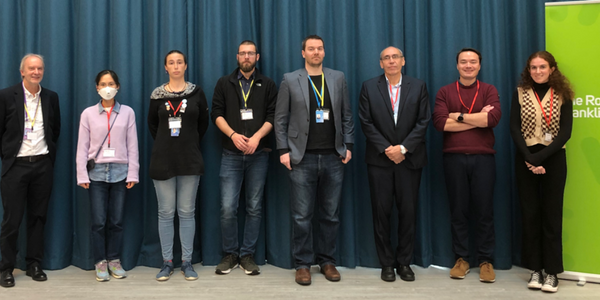With funding from the BBSRC Bioinformatics and Biological Resources scheme, we are setting up a hub for nanobody discovery at the Rosalind Franklin Institute with the overall aim of developing and expanding the use of nanobodies as molecular probes for structural and cell biology applications in the UK.
Nanobodies are recombinant antigen-specific single domain antibodies (VHHs) derived from the heavy chain only subset of camelid immunoglobulins. Their small molecular size, facile expression, high affinity, and stability have combined to make them unique targeting reagents with numerous applications in the biomedical sciences.
To promote the development and application of nanobodies, we organized a one-day workshop held at the Franklin on 20th October with fifty participants from the UK research community.
The day began with a keynote lecture from Prof. Serge Muyldermans, one of the co-inventors of nanobodies, who described the serendipitous discovery of heavy chain only antibodies in camel blood and the subsequent development of the technology for use in structural biology, diagnostics, and medical imaging.
This was followed by a series of short talks highlighting several key areas of nanobody technology, specifically, the generation of binders from synthetic libraries to produce anti-venoms and tools for membrane structural biology, the use of nanobodies in super-resolution imaging, strategies for chemical modification of nanobodies and computational approaches to manage and analyse nanobody sequences and structures.
These topics were followed up in three parallel breakout sessions at which some specific technical issues relating to the selection of nanobodies, their labelling for imaging and managing data were shared and discussed.
From the meeting it was clear that the question of whether to produce nanobodies by immunisation or screening synthetic libraries depends on the intended application. The camelid immune response generates the highest affinity binders, but for some uses, for example, in single particle cryo-EM, synthetic or non-immunised libraries provide more than adequate binders that can be generated quickly.
The discussion on data capture, management, and analysis provided an informatics perspective. Machine learning has already been applied to the prediction of nanobody structures and combined with the collection and curation of well-annotated nanobody sequences, has potential for the design of novel nanobodies to specific antigens.
The workshop provided useful insights and we thank all the invited speakers for excellent presentations and for sharing their experience.
We are planning a hands-on training workshop in nanobody generation in 2023. Look out for details on the Franklin website.

Speakers: Ray Owens (Chair), Huan Sun, Laura Zanetti-Domingues, Dimitrios Mamalis, Alex Lubbock, Serge Muyldermans, Simon Newstead and Eve Richardson